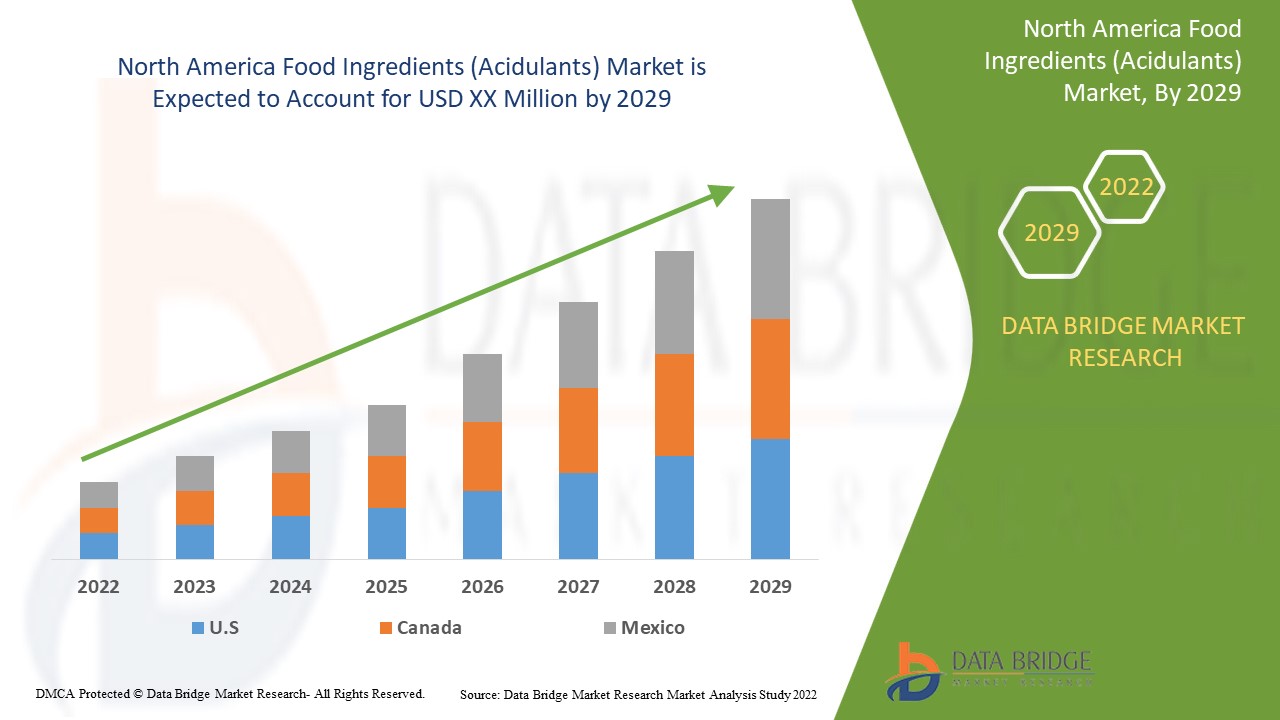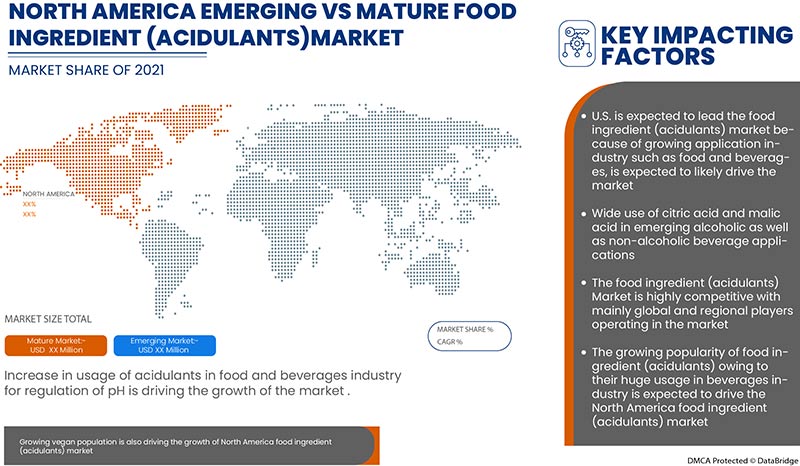North America Food Ingredients (Acidulants) Market, By Type (Citric Acid, Lactic Acid, Acetic Acid, Fumaric Acid, Tartaric Acid, Malic Acid, Gluconic Acid, Phosphoric Acid and Salts, Succinic Acid, Sodium Citrate, Potassium Citrate, Tannic Acid, Formic Acid, and Others), Form (Dry, and Liquid), Function (pH Control, Acidic Flavor Enhancer, Preservatives, and Others), Distribution Channel (B2B, and B2C), End-User (Food Processing Sector, Food Service Sector, and Household/Retail) Industry Trends and Forecast to 2029.
Market Analysis and Insights
The North America food ingredients (acidulants) market is gaining significant growth due to the growing food & beverage industry and the rise in demand for flavored drinks and food. The increase in demand for acidulants in alcoholic beverages such as wine also boosts the growth of the North America food ingredient (acidulants) market. However, stringent government regulations associated with acidulants and health risks associated with some acidulants, such as phosphoric acid, are expected to restrain the market's market growth during the forecast period.
Data Bridge Market Research analyses that the North America food ingredient (acidulants) market is expected to grow at a CAGR of 3.8% during the forecast period of 2022 to 2029.
|
Report Metric
|
Details
|
|
Forecast Period
|
2022 to 2029
|
|
Base Year
|
2021
|
|
Historic Years
|
2020 (Customizable to 2019- 2015)
|
|
Quantitative Units
|
Revenue in USD Million, Pricing in USD
|
|
Segments Covered
|
By Type (Citric Acid, Lactic Acid, Acetic Acid, Fumaric Acid, Tartaric Acid, Malic Acid, Gluconic Acid, Phosphoric Acid and Salts, Succinic Acid, Sodium Citrate, Potassium Citrate, Tannic Acid, Formic Acid, and Others), Form (Dry, and Liquid), Function (pH Control, Acidic Flavor Enhancer, Preservatives, and Others), Distribution Channel (B2B, and B2C), End-User (Food Processing Sector, Food Service Sector, and Household/Retail)
|
|
Countries Covered
|
U.S., Canada, and Mexico
|
|
Market Players Covered
|
Bartek Ingredients Inc., Corbion, FBC Industries, Cargill, Incorporated, ADM, DAIRYCHEM, Tate & Lyle, Jungbunzlauer Suisse AG, Foodchem International Corporation, Richest Group, INDUSTRIAL TECNICA PECUARIA, S.A., Direct Food Ingredients Ltd, Brenntag SE, Innova Corporate, Arihant Chemicals, among others
|
Market Definition
Acidulants are chemical compounds that give a tart, sour, or acidic flavor to foods or enhance the perceived sweetness of foods. Acidulants can also function as leavening agents and emulsifiers in some kinds of processed foods. Though acidulants can lower pH, they differ from acidity regulators, which are food additives specifically intended to modify food stability or enzymes within it. Typical acidulants are acetic acid (for instance, in pickles) and citric acid. Many beverages, such as colas, contain phosphoric acid. Sour candies often are formulated with malic acid. Other acidulants used in food production include fumaric acid, tartaric acid, lactic acid, and gluconic acid.
North America Food Ingredients (Acidulants) Market Dynamics
Drivers
- Growing demand for convenience food products is likely to favor food acidulants industry growth
Convenience and ready-to-go foods save time and energy, and thus, there is an increase in the demand for convenience food. This includes frozen foods, canned foods, ready-to-eat snacks, meals, chilled foods, soups and sauces, seasonings and dressings, noodles and pasta, and more. Consumers in the North American region majorly look for ease of use, high nutritional value, functionality, and quick delivery of convenience foods. Food processing and convenience food manufacturers are developing innovative and creative ideas to meet this demand. Furthermore, acidulants are the key ingredient used in the manufacturing of convenience food to add a refreshing flavor, improved texture, and tartness, and enhance the taste of the product.
Thus, the growing demand for convenience food processing is projected to drive the demand for acidulants over the years to come.
- Rise in demand for acidulants such as malic acid, lactic acid, and sodium lactate in the confectionery industry
Acidulants that are used in confectionery, such as malic acid, lactic acid, and sodium lactate, have a unique taste and flavor effects. It also boosts the impact of some aromatic flavor notes due to its volatility. In addition, nowadays, the combinations of acidulants are commonly used in confectionery. Furthermore, malic acid and fumaric acid provide more persistent sourness than other food acids at the same concentration, enhance fruit flavors, and boost the impact of high-intensity sweeteners.
Hence, the increased demand for confectionery products increases the demand for acidulants such as malic acid, lactic acid, fumaric acid, sodium lactate, and others by food manufacturers to fulfill the demands.
Opportunities
- Biological production of citric acid and acetic acid
Consumers are shifting towards sustainable products and are opting for products manufactured with the help of sustainable ingredients. Hence, the demand for sustainable and cost-effective and biological food ingredients (acidulants) such as citric acid and acetic acid is increasing among the manufacturers. However, bio-succinic acid production is quite difficult through a sustainable product that is microbial fermentation, although it is cost-effective.
Thus, due to the availability of a wide range of bacteria, fungi, and yeasts, biological production of acidulants can be increased, and sustainable bio-acidulants products can be offered to the global food & beverages industry, as it holds huge opportunity for food & beverages products that include biologically sustainable ingredients.
Restraints/Challenges
- High prices of acidulants
Fluctuating prices of raw materials such as plant-based sources and higher prices for better quality acidulants have increased acidulants' prices. Additionally, higher food taxes and growing demand for acidulants result in high prices.
Acidulants such as gluconic acid, tannic acid, and tartaric acid have slightly higher prices as these acidulants have fewer applications in food-grade products. Hence the demand is less, and the production of these acidulants for food-grade applications is minimum which results in higher prices. High prices of acidulants may change purchase patterns for food processing manufacturers over other acidulants.
- Rules and regulation of food regulatory bodies on acidulants products
The rules and regulations for the approval of acidulants laid by governmental bodies are to ensure that the acidulants have no side effects, which may restrict the growth of the global food ingredient (acidulants) market. The rising concern related to the side effects of acidulants on health has forced the government to lay down strict rules for product approval. The acidulants may lead to elevated blood pressure, the temporary reddish coloration of the eye, and others. Therefore, the amount of acidulant used is checked properly before using it in any product. Thus, the stringent regulations for the approval process may hamper the market's growth.
Post-COVID-19 Impact on North America Food Ingredients (Aciduants) Market
Post-COVID-19, the demand for acidulants is increased in North America due to a change in the buying pattern of consumers and a gradual shift towards increasing the demand for acidulants among various end-users such as food & beverages and others. Due to the discontinuation of many strict mandates and restrains, manufacturers and producers can fulfill the demand for acidulants in the region. In addition, the growing trend of trying new cuisines and soft drinks and fermented drinks among the young population will propel the market's growth.
The increased demand for fermented drinks enables manufacturers to launch innovative & flavored fermented drinks, which ultimately increases the demand for acidulants, which has helped the market grow.
North America Food Ingredients (Acidulants) Market Scope
The North America food ingredients (acidulants) market is segmented into type, form, function, distribution channel, and end-user. The growth amongst these segments will help you analyze meager growth segments in the industries and provide the users with a valuable market overview and market insights to make strategic decisions to identify core market applications.
Type
- Citric Acid
- Sodium Citrate
- Potassium Citrate
- Acetic Acid
- Formic Acid
- Gluconic Acid
- Fumaric Acid
- Malic Acid
- Phosphoric Acid And Salts
- Tartaric Acid
- Lactic Acid
- Tannic Acid
- Succinic Acid
- Others
On the basis of type, the North America food ingredients (acidulants) market is segmented into citric acid, sodium citrate, potassium citrate, acetic acid, formic acid, gluconic acid, malic acid, phosphoric acid and salts, tartaric acid, lactic acid, tannic, fumaric acid, succinic acid, and others.
Form
- Dry
- Liquid
On the basis of form, the North America food ingredients (acidulants) market is segmented into dry and liquid.
Function
- pH control
- Acidic flavor enhancer
- Preservatives
- Others
On the basis of function, the North America food ingredients (acidulants) market is segmented into pH control, acidic flavor enhancer, preservatives, and others.
Distribution Channel
- B2B
- B2C
On the basis of distribution channel, the North America food ingredients (acidulants) market is segmented into B2B and B2C.
End-User
- Household/Retail
- Food Processing Sector
- Food Service Sector
On the basis of end-user, the North America food ingredients (acidulants) market is segmented into household/retail, food processing sector, and food service sector.
North America Food Ingredients (Aciduants) Market Regional Analysis/Insights
The North America food ingredients (acidulants) market is analyzed, and market size insights and trends are provided by country, type, form, function, end-user, and distribution channel, as referenced above.
The countries covered in the North America food ingredients (acidulants) market report are the U.S., Canada, and Mexico.
The U.S. is expected to dominate the North America food ingredients (acidulants) market in terms of market share and revenue and will continue to flourish its dominance during the forecast period. This is due to the growing demand for acidulants in the U.S. to produce various types of food & beverages to fulfill the demands of consumers.
The country section of the report also provides individual market impacting factors and changes in regulations in the market that impact the current and future trends of the market. Data points, such as new and replacement sales, country demographics, disease epidemiology, and import-export tariffs, are some of the major pointers used to forecast the market scenario for individual countries. In addition, the presence and availability of North American brands and their challenges faced due to high competition from local and domestic brands and the impact of sales channels are considered while providing forecast analysis of the country data.
Competitive Landscape and North America Food Ingredients (Acidulants) Market Share Analysis
The North America food ingredients (acidulants) market competitive landscape provides details by the competitors. Details included are company overview, company financials, revenue generated, market potential, investment in research and development, new market initiatives, Europe presence, production sites and facilities, production capacities, company strengths and weaknesses, product launch, product width and breadth, and application dominance. The above data points provided are only related to the companies' focus on the North America food ingredients (acidulants) market.
Some of the key market players in the North America food ingredients (acidulants) market are Bartek Ingredients Inc., Corbion, FBC Industries, Cargill, Incorporated, ADM, DAIRYCHEM, Tate & Lyle, Jungbunzlauer Suisse AG, Foodchem International Corporation, Richest Group, INDUSTRIAL TECNICA PECUARIA, S.A., Direct Food Ingredients Ltd, Brenntag SE, Innova Corporate, Arihant Chemicals, among others.
Research Methodology
Data collection and base year analysis are done using data collection modules with large sample sizes. The market data is analyzed and estimated using market statistical and coherent models. In addition, market share analysis and key trend analysis are the major success factors in the market report. The key research methodology used by the DBMR research team is data triangulation which involves data mining, analysis of the impact of data variables on the market, and primary (industry expert) validation. Apart from this, data models include Vendor Positioning Grid, Market Time Line Analysis, Market Overview and Guide, Company Positioning Grid, Company Market Share Analysis, Standards of Measurement, North America Vs Regional, and Vendor Share Analysis. Please request an analyst call in case of further inquiry.
SKU-



